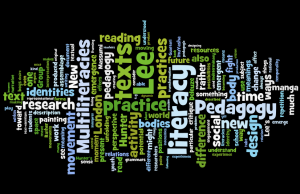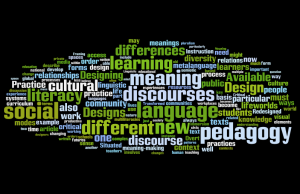YouTube Clip (a mystery until tomorrow!)
Summary:
We thought this short clip an appropriate lead-in as the article considers the way advertisements (among other visual media) are constructed and how the deliberate construction of visual media influences viewers often subliminally, as the advertising agents fell prey to in this short clip.
In brief: The article’s goal is to raise awareness about the constructedness of visual media and to promote visual literacy in students and their practice of the critical reading of visual forms.
Manipulating visual media to achieve the desired effect on the viewer – advertisers take advantage of this all the time.
This article stresses the importance of students gaining critical skills to be able to work through visual media.
SOME PRINCIPLES OF BUILDING VISUAL IMAGES (these are important to the construction of visual art, says Farmer)
“- A dot implies a focus or location.
– A line signifies borders and movement. Lines may be strong, dynamic, tentative, wavy, erratic, etc.
– Scale shows relationship of size between two objects, with the larger one usually connoting more power
– dimension suggests three dimensions and perspective; well-executed images may seem more real and credible
– texture generated tactile and visual sensations: of roughness, luxury, softness, age, and even revulsion
– value shows the lightness or darkness of an image; light is often associated with goodness and airiness while darkness may connote power and doom.”
Interesting to keep in mind is cultural difference especially in terms of the use of colour in a visual piece:
– In some cultures, yellow may be the colour of royalty – in others, it may be the colour of cowardice
– In some cultures, black may be the colour of death – in others, white may be representative of death
— without a knowledge of another culture’s visual coding system, it is possible that students may mis-read the image
It is now possible, with technology, to easily manipulate and change an image:
– cropping images to manipulate the context of the image
– changing the value and saturation of an image to change the emphasis of the image
– altering the hue of the image to mislead a viewer’s interpretation
– changing the relative size of the image to change it’s relative importance and perceived power in a frame
– adding or eliminating images to distort the truth
— the author stresses that students must be aware of how an image is constructed and how an image can be manipulated
— it is necessary to have learning activities that help students read visual images, analyze the producer of the image’s intent and just what the image is trying to convince the viewer to do/think
– think analyzing propaganda (this is a direct example of image construction, which seems obviously biased and forcefully persuasive as we analyze it in hindsight), similarly advertisements and other forms of visual media have been constructed with directed intent to manipulate a target audience
Suggestions for Activities (pg. 31):
Farmer suggests a range of activities, most of which have somewhat political explorations. Most of these can be easily used in an English, Socials, or Art classroom.
• Ask students to critique the visual images found in school and local publications: newsletters, yearbooks, and videos. What content is represented or omitted (e.g., gender, ethnicity, subgroups)? What perspectives are represented? What messages are being conveyed? What visual principles are used to convey those messages?
• Teach students how to manipulate images using photo editing software. Ask student pairs to manipulate an image to send opposing messages (e.g., one pro and one con). Ask peers to analyze the resultant visual images in light of the visual principles used.
• Ask students to photograph or videotape their schools or neighborhoods, and then compare their photos in terms of subject matter choice, perspective, and visual principles used. They might focus on people and compare their images. Then ask them to edit and sequence the images to communicate a persuasive message (e.g., athletic recruitment, real estate enticement, clean-up campaign).
• Ask students to locate online images about a social issue, and then analyze images in light of the disseminator’s perspective and intent. Ask them to identify how visual elements and principles are used to convey the underlying message.
• Ask students to locate online images about an international issue; each student (or small group) might choose a different country or culture. Ask them what visual principles appear to be universally applied or culturally defined. To what extent does culture impact the message?
• Consider visual representations of Canadian History. Which perspectives are present? Omitted? Do any of the images seems propagandistic? How might the pictures be different if they were from an alternate viewpoint? (Based on gender, race, socioeconomic status, etc.)
• Download a video of a public event or political rally. Ask students to edit that raw footage to create a 30-second advertisement or political announcement that intends to persuade the viewer to respond in a specific way. Each student (or small group) could be assigned a different audience (e.g., single mothers, rural poor, big business, senior citizens) to target his or her message.
Tips for students (how to critically analyze images):
The article includes a list of suggestions as to what teachers can do to help their students be more critical viewers. The author draws on Silverblatt (2001), who has created a framework that prescribes the following questions for viewers to consider:
1. What is the premise? Is it logical? What assumptions are made?
2. What is the explicit or implicit content?
3. What is the historical and cultural context? What worldview is being represented?
4. What is the emotional response? (I would say what is your response and what is the desired response, do you think?)
5. What genres or conventions are being used?
6. What is the conclusion or inference? Is it logical?
Farmer also includes the Centre for Media Literacy’s suggestions (2005) for how to be an analytical, thoughtful audience for persuasive instruments.
1. Who created the message?
2. Why was the message created and disseminated?
3. What visual techniques are used to draw attention to the message?
4. How might people experience the image differently?
5. What values, lifestyle, points of view are represented or omitted?
Both these are useful frameworks to consider. The second one is a bit more intuitive, as it follows the “who, what when, where, why?” model that students may already be familiar with.
Activity:
● intro activity by showing imgur variations on a picture challenge to make posters for different movie genres:
original image: http://i.imgur.com/ocehWZk.jpg
as rom-com: http://i.imgur.com/9hYwToq.jpg?1
as a novel: http://i.imgur.com/77q0JNx.jpg
as horror: http://i.imgur.com/tRrO9oi.jpg
● give groups of students different pictures/ ads from various magazines
● challenge students to manipulate/ change the photos to target a different demographic of their own choosing (e.g. male vs. female, kids vs. adults, teens vs. 40somethings, etc.) — OR to change the ad so that it’s advertising a completely different product/ idea
Discussion Questions:
1. Is it possible to overcome the power of subliminal messages? If not, what danger to the individual, if any, might this imply?
2. Do you think you would use any of these activities in your own classroom? Have you ever used activities like these in the classroom before?
3. How do you empower students to take visual literacy tools with them from the classroom into their daily lives? How do you ensure that building an awareness of visual image construction doesn’t stop with classroom learning?
4. How might you introduce your students to the “tips” for critical viewing we’ve covered? Do you think they’re worth sharing?
Works Cited
I See, I Do: Persuasive Messages and Visual Literacy. By: Farmer, Lesley S. J., MultiMedia & Internet@Schools, 15464636 Jul/Aug2007, Vol. 14, Issue 4
By: Allison Dixon, Ashlee Petrucci, Ilana Finkleman, Shannon Smart

